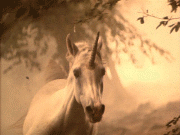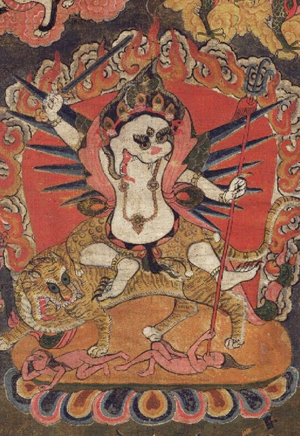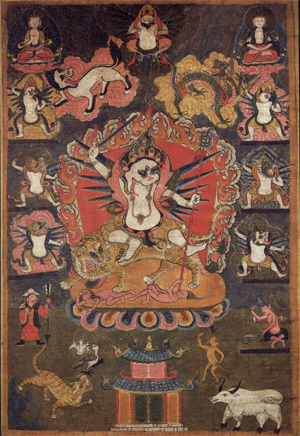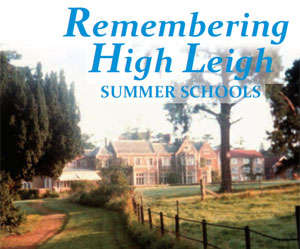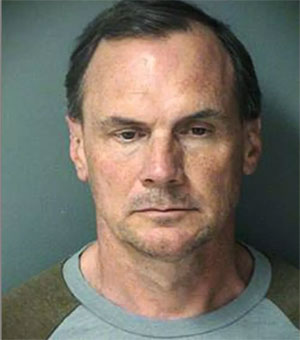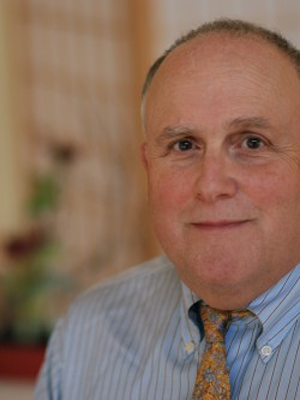Chögyam Trungpaby Wikipedia
Accessed: 6/30/19
NOTICE: THIS WORK MAY BE PROTECTED BY COPYRIGHTYOU ARE REQUIRED TO READ
THE COPYRIGHT NOTICE AT THIS LINK BEFORE YOU READ THE FOLLOWING WORK, THAT IS AVAILABLE SOLELY FOR PRIVATE STUDY, SCHOLARSHIP OR RESEARCH PURSUANT TO 17 U.S.C. SECTION 107 AND 108. IN THE EVENT THAT THE LIBRARY DETERMINES THAT UNLAWFUL COPYING OF THIS WORK HAS OCCURRED, THE LIBRARY HAS THE RIGHT TO BLOCK THE I.P. ADDRESS AT WHICH THE UNLAWFUL COPYING APPEARED TO HAVE OCCURRED. THANK YOU FOR RESPECTING THE RIGHTS OF COPYRIGHT OWNERS.
They kept pouring in, their numbers rising from thirty thousand [30,000] to seventy thousand [70,000].....
At one point during this stage of her life she had an inexplicable insight. Freda "saw" that Tibetan Buddhism would not only travel to the West but would take root there. And the ones who would bring it about would be the tulkus, Tibet's recognized reincarnated high lamas and spiritual masters, who held the essence of the teachings.....
In the early 1960s, Buddhism was still virtually unknown in the West, outside of a very small handful of scholars ... In the eyes of the intellectual Buddhist scholars, Tibetan Buddhism was regarded as degenerate -- shrouded in the magic and mystery fostered by those shamans of the Bon religion that existed in Tibet before Buddhism took root. There was too much ritual, too much Tantra, too much mumbo jumbo....
There was also the matter of reincarnation itself, which in the predominantly Christian West was still regarded as heretical. People had been burned at the stake and been killed en masse (such as the Cathars) for believing such anathema. In the 1960s and 1970s reincarnation was still a taboo subject. The Tibetans, however, not only completely accepted reincarnation as a given fact of life, they went farther than any other Buddhist country by devising a system to find specific rebirths of accomplished spiritual masters who had forsaken higher states of consciousness after death in order to be reborn in an earthly body solely to continue to teach others how to reach the same exalted state they had achieved. The voluntary return to this vale of tears was seen as the highest mark of altruism, brave and noble beyond measure. These were the tulkus, titled rinpoches, or "Precious Ones." They were the cream of Tibetan society, revered, feted, and sometimes unwittingly used as pawns in others' games of corruption. These were the people Freda was now planning to bring to the West to plant the seeds of the Buddha's teachings into American, European, and Australian soil for the first time.
Finding the right candidates, however, posed an enormous problem. The entire community of Tibetan refugees was in total disarray, with lamas, yogis, householders, carpenters, tailors, and others, mingling together in a homogenized, indistinguishable mass formerly unheard of in the conservative, strictly hierarchical society of old Tibet, where Tulkus were kept apart from the hoi polloi for fear of contamination ....
Undeterred by, or unaware of, these seeming obstacles Freda forged ahead with her dream. She had seen for herself what she thought were exceptional, special qualities in the handful of tulkus she had come across amid the mayhem of the camps. To her eyes they exuded an unmistakable refinement, wisdom, maturity, and dignity way beyond their years, which she was convinced would be as attractive to Westerners as it was to her....
Trungpa was installed as the principal of the Young Lamas Home School, and Akong was its manager. When all was complete, Freda had an audience with Nehru to thank him profusely for his help. Nehru smiled and said in a low, quiet voice, "It was not for you I did it." Nevertheless Freda had single-handedly planned and brought into being the Young Lamas Home School. She had succeeded in her pioneering task to bring the tulkus into the twentieth century, and she was on her way to realizing the next stage of her vision -- to bring them to the West.....
The tulkus were learning English and their lessons on the modern world with varying degrees of success. Freda's star student, Trungpa Rinpoche, however, was making exceptional progress, and Freda's aspirations for him became increasingly ambitious. He had a natural aptitude for English and had taken to reading the poets that Freda presented him with, especially T.S. Eliot. He was keen on history and geography too. Freda decided that he was ready to try to get into Oxford, her own university, where he would receive the finest education the West had to offer. With such credentials he would be perfectly equipped and have the clout to bring the sacred Buddhist teachings to the outside world in a language it could understand.
With the help of John Driver, an Englishman who was also tutoring Trungpa, Freda set about getting a Spalding Scholarship for Trungpa, and succeeded. In early 1963 Trungpa set sail for England accompanied by Akong Rinpoche, to enter into the arcane, privileged, and hallowed halls of Oxford University. It was another epic journey into the unknown, heralding as many adventures, pitfalls, and triumphs as they had met in their escape from Tibet.
-- The Revolutionary Life of Freda Bedi, by Vicki Mackenzie
On January 17, 1960, they crossed the border into India.
Rinpoche spent nearly four years in India, where he encountered a world vastly different from Tibet. He had grown up in an essentially medieval culture, and a very unusual one at that. It was one of the very few places on earth, at least in the twentieth century, where spirituality was uppermost in the minds and hearts of almost the entire population. Tibet was certainly not an idyllic society. Rinpoche often said that there was it great deal of corruption in Tibet, and that this was a contributing factor in its occupation by the communist Chinese. At the same time, he loved the land and the people, and he was completely immersed in a Buddhist world there.
In Tibet, he had been a very special and privileged person. In India, the Tibetans were refugees and were not generally treated very well, although kindness was extended to them by the Indian government and many individuals living in India. However, Rinpoche was no longer a person of high status, as he had been. He told me that, not long after arriving in India, he was invited to an English garden party. The hostess was passing around a tray of cucumber sandwiches, which she offered first to Rinpoche. He took the whole tray, thinking that she had made a nice lunch for him. Later, he was quite embarrassed by this.
Many of the Tibetan refugees ended up in camps. He stayed in the camps for a short time, but then he was able to relocate to Kalimpong, which was close to the seat that His Holiness the Karmapa established in Sikkim after escaping from Tibet. While he was in Kalimpong, Rinpoche studied thangka painting, and he produced beautiful paintings of Padmasambhava and his consort Yeshe Tsogyal, as well as other subjects. Later, he was able to bring these paintings with him to the West, and one of them hangs in my house today. He became friends with Tendzin Rongae, a wonderful thangka painter who had also recently arrived from Tibet and helped Rinpoche with his painting. Rinpoche became close to the entire Rongae family. While in Kalimpong, he learned that Dilgo Khyentse Rinpoche had also recently entered India and was living a few miles away, about an hour away by foot. Rinpoche used to walk over to see Khyentse Rinpoche and to receive teachings from him. Dilgo Khyentse was over six feet tall, very unusual for a Tibetan, and he had enormous warmth and presence. During this time, Rinpoche became friends with Khyentse Rinpoche's nephew Ato Rinpoche.
India is a significant place for Tibetans because it was the home of the Buddha and of many of the great teachers whose works are studied in Tibet. One could say that India is for Tibetans what the Middle East is for Jews, Muslims, and Christians. There are many Buddhist pilgrimage sites in India. Rinpoche was able to visit Bodhgaya, where the Buddha attained enlightenment, and other important sites.
In India, Rinpoche was also exposed to many non-Buddhist cultures for the first time. He came to love Indian food and to appreciate many things about the Indian culture. He encountered people from all over the world there. In particular, he met several English Buddhists who were extremely kind and helpful to him. Freda Bedi was one of these. She was an Englishwoman who had married an Indian, Baba Bedi. She worked for the Central Social Welfare Board of the Indian government helping Tibetan refugees, and she was so affected by her involvement with the Tibetans that she became a Buddhist herself. After her husband's death, she was one of the first Westerners to become a Tibetan Buddhist nun.
Rinpoche met her at the refugee camp in Bir, and she formed an immediate bond with him. From the earliest contacts he had with Westerners, he shone out like a light or a beacon to them. Lama Govinda, a Westerner and an early writer about Tibetan Buddhism, reported this quality. Lama Govinda met Rinpoche in northern India, just after Rinpoche's escape from Tibet. Many Tibetan refugees stayed at Lama Govinda's house in the Himalayas on their way south, and he said that Trungpa Rinpoche was the brightest of them all.
Freda Bedi helped Rinpoche resettle in Kalimpong, and later she asked him to help her establish a school to train young Tibetan monks, the Young Lamas Home School, in New Delhi, which moved to Dalhousie after about a year. He was delighted to do this, and with the blessings of His Holiness the Dalai Lama, Rinpoche became the spiritual advisor to the young monks at the school.
This was the first time that Rinpoche had ever lived in a secular society, and although at first he found it quite strange, he soon took to it. He went to meetings of a British women's club so that he could hear the poetry of
T.S. Eliot read, and he used to go to the cinema in New Delhi. On his way out of Tibet, close to the border with India, he was exposed to alcoholic beverages for the first time. In one of the villages where they stopped, you couldn't drink the water, and everyone drank a kind of Tibetan beer. He had been hesitant to imbibe any alcohol since it was a violation of his monastic vows, but once he gave in, he enjoyed the experience, an din India he started to drink occasionally, though not openly. Tendzin Rongae and Rinpoche liked to get together and drink from time to time.
On the way out of Tibet, Rinpoche had fallen in love with a young Tibetan nun, Konchok Paldron, who was part of the escape party. He became clandestinely involved with her while he was in India. She was living in the refugee camp in Bir. She visited him at the Young Lamas Home School, and they took a mattress up on the roof of the building, where they spent the night together. She became pregnant and gave birth to Rinpoche's eldest son, Osel Rangdrol Mukpo, a short time before Rinpoche left for England. When she was pregnant, she made a pilgrimage to Bodhgaya, and their son was born there. She could no longer be a nun, so after Osel was born, she worked as a road laborer to support herself for some time. Later, she married and had another child.Around this time, Rinpoche received a
Spaulding [Spalding] Scholarship to attend Oxford University. This had come through the intercession of
Freda Bedi and
John Driver, an Englishman who tutored Rinpoche in the English language in India and helped him with his studies later at Oxford.
The Tibet Society in the United Kingdom had also helped him to get the scholarship.
To go to England, Rinpoche needed the permission of the Dalai Lama's government. They would never have have allowed him to leave if they had known about his sexual indiscretion, nor do I think it would have gone over very well with the Tibet Society or his English friends in New Delhi. He and Konchok Paldron kept their relationship a secret, and it was a long time before anyone knew that Rinpoche was the father of her child. This caused him a great deal of pain, although I also think that he hadn't yet entirely faced up to the implications of the direction he was going in his relationships with women. At that time, in spite of the inconsistencies in his behavior, he still seemed to think that he could make life work for himself as a monk. Rinpoche continued to stay in touch with Konchok Paldron and his son Osel, and a few years later, he returned to see them and to make arrangements for his son to come to England.
Rinpoche sailed from Bombay for England early in 1963, on the P&O Line, accompanied by his close friend Akong, who was to be a helper and companion to him at Oxford. Rinpoche had been working very hard on his English, but when he left India, he was still struggling with the language, speaking what would be called a form of pidgin English.
When Rinpoche and Akong docked in England, they were welcomed by members of the Tibet Society, and before his studies started at Oxford in the fall, Rinpoche spent time in London, where he met many of the most prominent members of the English Buddhist community. He was invited to give several talks at the Buddhist Society, and he attended a kind of summer camp they sponsored each year, where he gave a number of lectures.... When he went up to Oxford, he had quite a challenge trying to bring his English up to speed so that he could understand the lectures and the books he was given to read. Rinpoche wanted to learn as much as he could about English history, philosophy, religion, and politics, but it was pretty tough going for him at the beginning. John Driver, who he had met in India and who had been instrumental in bringing him to England, returned to England and helped Rinpoche a great deal with his lessons, and Rinpoche never forgot this kindness. In the evenings, Rinpoche attended classes in the town of Oxford to improve his English. Years later, he still remembered how his teacher had made the class say words over and over, to improve their elocution, such as "policeman, policeman, policeman." Rinpoche proved himself a brilliant student of the English language. By the time he left England for America, his English vocabulary exceeded that of many of his students.
At Oxford Rinpoche was befriended by the Jesuits, who thought that
his tremendous enthusiasm for learning about the Christian religion made him a good candidate for conversion. Of course, nothing could be further from the truth, but Rinpoche enjoyed their company and felt that here at least he had found Westerners who had some understanding of a wisdom tradition, even though it was not his own.
-- Dragon Thunder: My Life with Chogyam Trungpa, by Diana J. Mukpo, Carolyn Rose Gimian
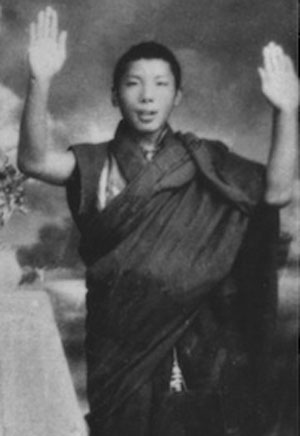
Chögyam Trungpa before 1959
Title Tulku
Personal
Born March 5, 1939
Nangchen, Kham region, Tibet
Died April 4, 1987 (aged 48)
Halifax, Nova Scotia
Cause of death Myocardial infarction and Liver cirrhosis[1]
Religion Buddhism
Nationality Tibetan
Spouse Lady Diana Mukpo
Children Sakyong Mipham Rinpoche, Tagtrug (Taggie) Mukpo, Gesar Mukpo
School Vajrayana
Lineage Kagyu and Nyingma
Senior posting
Teacher Jamgon Kongtrul of Sechen
Dilgo Khyentse Rinpoche
Khenpo Gangshar
Predecessor Chökyi Nyinche
Successor Choseng Trungpa
Reincarnation Trungpa Tulku
Website
http://www.shambhala.org/Chögyam Trungpa (Wylie: Chos rgyam Drung pa; March 5, 1939 – April 4, 1987) was a Buddhist meditation master and holder of both the Kagyu and Nyingma lineages, the eleventh Trungpa tülku, a tertön, supreme abbot of the Surmang monasteries, scholar, teacher, poet, artist, and originator of a radical re-presentation of Shambhala vision.
Recognized both by Tibetan Buddhists and by other spiritual practitioners and scholars[2][3] as a preeminent teacher of Tibetan Buddhism, he was a major figure in the dissemination of Buddhism to the West,[4] founding Vajradhatu and Naropa University and establishing the Shambhala Training method.
Among his contributions are the translation of numerous Tibetan texts,[5] the introduction of the Vajrayana teachings to the West, and a presentation of the Buddhadharma largely devoid of ethnic trappings. Trungpa coined the term crazy wisdom.[6] Some of his teaching methods and actions were the topic of controversy during his lifetime and afterwards.
Biography
Early years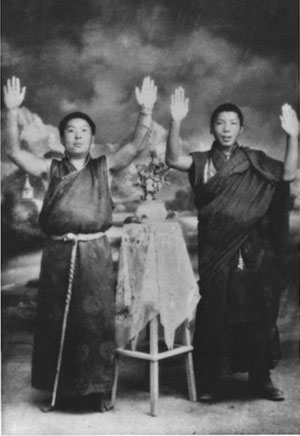 Khenpo Gangshar (left) and Chögyam Trungpa
Khenpo Gangshar (left) and Chögyam TrungpaBorn in the Nangchen region of Tibet in March 1939, Chögyam Trungpa was eleventh in the line of Trungpa tülkus, important figures in the Kagyu lineage, one of the four main schools of Tibetan Buddhism. Among his three main teachers were Jamgon Kongtrul of Sechen, HH Dilgo Khyentse Rinpoche, and Khenpo Gangshar.
The name Chögyam is a contraction of Chökyi Gyamtso (Tibetan: ཆོས་ཀྱི་རྒྱ་མཚོ་, Wylie: Chos-kyi Rgya-mtsho), which means "ocean of dharma". Trungpa (Tibetan: དྲུང་པ་, Wylie: Drung-pa) means "attendant". He was deeply trained in the Kagyu tradition and received his khenpo degree at the same time as Thrangu Rinpoche; they continued to be very close in later years. Chögyam Trungpa was also trained in the Nyingma tradition, the oldest of the four schools, and was an adherent of the ri-mé ("nonsectarian") ecumenical movement within Tibetan Buddhism, which aspired to bring together and make available all the valuable teachings of the different schools, free of sectarian rivalry.
At the time of his escape from Tibet,[7] Trungpa was head of the Surmang group of monasteries.
Escape from TibetOn April 23, 1959, twenty-year-old Trungpa set out on an epic nine-month escape from his homeland.[8][9] Masked in his account in Born in Tibet to protect those left behind,[10] the first, preparatory stage of his escape had begun a year earlier, when he fled his home monastery after its occupation by the Chinese People’s Liberation Army (PLA).[11] After spending the winter in hiding, he decided definitively to escape after learning that his monastery had been destroyed.[12] Trungpa started with Akong Rinpoche and a small party of monastics, but as they traveled people asked to join until the party eventually numbered 300 refugees, from the elderly to mothers with babies – additions which greatly slowed and complicated the journey. Forced to abandon their animals, over half the journey was on foot as the refugees journeyed through an untracked mountain wilderness to avoid the PLA. Sometimes lost, sometimes traveling at night, after three months’ trek they reached the Brahmaputra River. Trungpa, the monastics and about 70 refugees managed to cross the river under heavy gunfire,[13] then, eating their leather belts and bags to survive, they climbed 19,000 feet over the Himalayas before reaching the safety of Pema Ko.[14] After reaching India, on January 24, 1960 the party was flown to a refugee camp.[15][16]
Between 2006 and 2010, independent Canadian and French researchers using satellite imagery tracked and confirmed Trungpa’s escape route.[17] In 2012, five survivors of the escape in Nepal, Scotland and the U.S. confirmed details of the journey and supplied their personal accounts.[18] More recent analysis has shown the journey to be directly comparable to such sagas as Shackleton’s 1914/17 Antarctic Expedition.[19] In 2016 accumulated research and survivors’ stories were published in a full retelling of the story,[20] and later in the year preliminary talks began on the funding and production of a movie.
Early teachings in the WestIn exile in India, Trungpa began his study of English. In collaboration with Freda Bedi, who had initiated the project,[21] Trungpa and Akong Tulku founded the Young Lamas Home School and, after seeking endorsement from the Dalai Lama, were appointed its spiritual head and administrator respectively.[22]
In 1963, with the assistance of sympathetic Westerners, Trungpa received a Spalding sponsorship to study comparative religion at St Antony's College, Oxford University.[23][24] In 1967, upon the departure of the western Theravadan monk Anandabodhi, Trungpa and Akong Rinpoche were invited by the Johnstone House Trust in Scotland to take over a meditation center, which then became Samye Ling, the first Tibetan Buddhist monastery in the West (future actor and musician David Bowie[25] was one of Trungpa's meditation pupils there). In 1970, after a break with Akong, Trungpa moved to the United States at the invitation of several students.
Shortly after his move to Scotland, a variety of experiences, including a car accident that left him partially paralyzed on the left side of his body, led Trungpa to give up his monastic vows and work as a lay teacher.[26] He made that decision principally to mitigate students' becoming distracted by exotic cultures and dress and to undercut their preconceptions of how a guru should behave.[26] He drank, smoked, slept with students, and often kept students waiting for hours before giving teachings. Much of his behavior has been construed as deliberately provocative and sparked controversy. In one account, he encouraged students to give up smoking marijuana, claiming that the smoking was not of benefit to their spiritual progress and that it exaggerated neurosis. Students were often angered, unnerved and intimidated by him, but many remained fiercely loyal, committed, and devoted.
Upon moving to the United States in 1970, Trungpa traveled around North America, gaining renown for his ability to present the essence of the highest Buddhist teachings in a form readily understandable to Western students. During this period, he conducted 13 Vajradhatu Seminaries, three-month residential programs at which he presented a vast body of Buddhist teachings in an atmosphere of intensive meditation practice. The seminaries also had the important function of training his students to become teachers themselves.[27]
Introduction of the VajrayanaTrungpa was one of the first teachers to introduce the esoteric practice of the Vajrayana to the West. According to Khenpo Tsultrim Gyamtso, "The one who mainly spread the Vajrayana in the West was Trungpa Rinpoche."[28] In contrast to its traditional presentation in Tibet, where the esoteric practices are largely the domain of the monastic sangha, in the US Trungpa introduced the Vajrayana to the lay sangha.[29]
The presentation of these teachings gave rise to some criticism. According to Trungpa's former student Stephen Butterfield, "Trungpa told us that if we ever tried to leave the Vajrayana, we would suffer unbearable, subtle, continuous anguish, and disasters would pursue us like furies".[30] Other Vajrayana teachers also warn their students about the dangers of the esoteric path.
Butterfield noted "disquieting resemblances" to cults, and "to be part of Trungpa's inner circle, you had to take a vow never to reveal or even discuss some of the things he did." But Butterfield also notes that "This personal secrecy is common with gurus, especially in Vajrayana Buddhism,"[31] and acknowledges that Trungpa's organization is anything but a cult: "a mere cult leaves you disgusted and disillusioned, wondering how you could have been a fool. I did not feel that charlatans had hoodwinked me into giving up my powers to enhance theirs. On the contrary, mine were unveiled."[32]
Meditation and education centers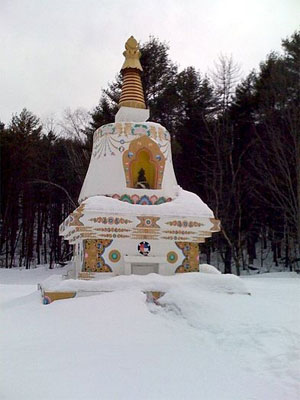 The purkhang at Karmê Chöling
The purkhang at Karmê ChölingIn 1973, Trungpa established Vajradhatu, encompassing all his North American institutions, headquartered in Boulder, Colorado. Trungpa also founded more than 100 meditation centers throughout the world. Originally known as Dharmadhatus, these centers, now more than 150 in number, are known as Shambhala Meditation Centers. He also founded retreat centers for intensive meditation practice, including Shambhala Mountain Center in Red Feather Lakes, Colorado, Karmê Chöling in Barnet, Vermont and Gampo Abbey in Cape Breton, Nova Scotia.
In 1974, Trungpa founded the Naropa Institute, which later became Naropa University, in Boulder, Colorado. Naropa was the first accredited Buddhist university in North America. Trungpa hired Allen Ginsberg to teach poetry and William Burroughs to teach literature.
Trungpa had a number of notable students, among whom were Pema Chödrön, Allen Ginsberg, Peter Orlovsky, Anne Waldman, Diane di Prima, Peter Lieberson, John Steinbeck IV, José Argüelles, David Nichtern, Ken Wilber, David Deida, Francisco Varela, and Joni Mitchell, who portrayed Trungpa in the song "Refuge of the Roads" on her 1976 album Hejira.[33] Ginsberg, Waldman, and di Prima also taught at Naropa University, and in the 1980s Marianne Faithfull taught songwriting workshops. Lesser-known students Trungpa taught in England and the US include Alf Vial, Rigdzin Shikpo (né Michael Hookham), Jigme Rinzen (né P. Howard Useche), Ezequiel Hernandez Urdaneta (known as Keun-Tshen Goba after setting up his first meditation center in Venezuela), Miguel Otaola (aka Dorje Khandro), Francisco Salas Roche, and Francesca Fremantle. Rigdzin Shikpo promulgated Trungpa's teachings from a primarily Nyingma rather than Kagyü point of view at the Longchen Foundation.[34][35]
Shambhala visionIn 1976, Trungpa began giving a series of secular teachings, some of which were gathered and presented as the Shambhala Training,[36][37] inspired by his vision (see terma) of the legendary Kingdom of Shambhala. Trungpa had actually started writing about Shambhala before his 1959 escape from Tibet to India, but most of those writings were lost during the escape.[38]
In his view not only was individual enlightenment not mythical, but the Shambhala Kingdom, an enlightened society, could in fact be actualized. The practice of Shambhala vision is to use mindfulness/awareness meditation as a way to connect with one's basic goodness and confidence. It is presented as a path that "brings dignity, confidence, and wisdom to every facet of life." Trungpa proposed to lead the Kingdom as sakyong (Tib. earth protector) with his wife as queen-consort or sakyong wangmo.
Shambhala vision is described as a nonreligious approach rooted in meditation and accessible to individuals of any, or no, religion. In Shambhala terms, it is possible, moment by moment, for individuals to establish enlightened society. His book, Shambhala: The Sacred Path of the Warrior, provides a concise collection of the Shambhala views. According to Trungpa, it was his intention to propagate the kingdom of Shambala that provided the necessary inspiration to leave his homeland and make the arduous journey to India and the West.[39]
Work with arts and sciencesFrom the beginning of his time in the US, Trungpa encouraged his students to integrate a contemplative approach into their everyday activities. In addition to making a variety of traditional contemplative practices available to the community, he incorporated his students' already existing interests (especially anything relating to Japanese culture), evolving specialized teachings on a meditative approach to these various disciplines. These included kyūdō (Japanese archery), calligraphy, ikebana (flower arranging), Sadō (Japanese tea ceremony), dance, theater, film, poetry, health care, and psychotherapy. His aim was, in his own words, to bring "art to everyday life." He founded the Nalanda Foundation in 1974 as an umbrella organization for these activities.[citation needed]
DeathTrungpa visited Nova Scotia for the first time in 1977. In 1983 he established Gampo Abbey, a Karma Kagyü monastery in Cape Breton. The following year, 1984–85, he observed a yearlong retreat at Mill Village and in 1986 he moved his home and Vajradhatu's international headquarters to Halifax.
By then he was in failing health due to the auto accident in his youth and years of heavy alcohol use. On September 28, 1986, he suffered cardiac arrest,[40] after which his condition deteriorated, requiring intensive care at the hospital, then at his home and finally, in mid-March 1987, back at the hospital, where he died on April 4, 1987.
In 2006 his wife, Diana Mukpo, wrote, "Although he had many of the classic health problems that develop from heavy drinking, it was in fact more likely the diabetes and high blood pressure that led to abnormal blood sugar levels and then the cardiac arrest".[41] But in a November 2008 interview, when asked "What was he ill with? What did he die of?," Trungpa's doctor, Mitchell Levy, replied, "He had chronic liver disease related to his alcohol intake over many years."[42] One of Trungpa's nursing attendants reported that he suffered in his last months from classic symptoms of terminal alcoholism and cirrhosis,[43] yet continued drinking heavily. She added, "At the same time there was a power about him and an equanimity to his presence that was phenomenal, that I don't know how to explain."[44]
Trungpa is reported to have remained in a state of samādhi for five days after his death, his body not immediately decaying and his heart remaining warm.[45] His body was packed in salt, laid in a wooden box, and conveyed to Karmê Chöling. A number of observers have reported that his cremation there on May 26, 1987, was accompanied by various atmospheric effects and other signs traditionally viewed as marks of enlightenment. These included the appearance of rainbows, circling eagles,[46][47] and a cloud in the shape of an Ashe.[48][49]
Continuation of the Shambhala lineageUpon Trungpa's death, the leadership of Vajradhatu was first carried on by his American disciple, appointed regent and Dharma heir, Ösel Tendzin (Thomas Rich), and then by Trungpa's eldest son and Shambhala heir, Sakyong Mipham Rinpoche.
The next Trungpa tülku, Chokyi Sengay, was recognized in 1991 by Tai Situ Rinpoche.
AcclaimMajor lineage holders of Trungpa's Tibetan Buddhist traditions and many other Buddhist teachers supported his work.
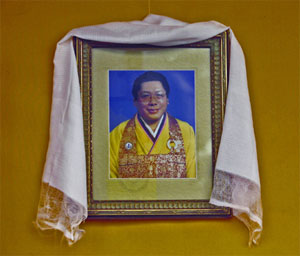 Chogyam Trungpa Rinpoche
Chogyam Trungpa RinpocheIn 1974, Trungpa invited the 16th Karmapa, head of the Karma Kagyu lineage, to come to the West and offer teachings. Based on this visit, the Karmapa proclaimed Trungpa one of the principal Kagyu lineage holders in the west:
The ancient and renowned lineage of the Trungpas, since the great siddha Trungmase Chökyi Gyamtso Lodrö, possessor of only holy activity, has in every generation given rise to great beings. Awakened by the vision of these predecessors in the lineage, this my present lineage holder, Chökyi Gyamtso Trungpa Rinpoche, supreme incarnate being, has magnificently carried out the vajra holders' discipline in the land of America, bringing about the liberation of students and ripening them in the dharma. This wonderful truth is clearly manifest.
Accordingly, I empower Chögyam Trungpa Vajra Holder and Possessor of the Victory Banner of the Practice Lineage of the Karma Kagyu. Let this be recognized by all people of both elevated and ordinary station.[50]
In 1981, Trungpa and his students hosted the 14th Dalai Lama in his visit to Boulder, Colorado. Of Trungpa, the Dalai Lama later wrote, "Exceptional as one of the first Tibetan lamas to become fully assimilated into Western culture, he made a powerful contribution to revealing the Tibetan approach to inner peace in the West."[51]
Trungpa also received support from one of his own main teachers, Dilgo Khyentse Rinpoche, head of the Nyingma lineage. In addition to numerous sadhanas and poems dedicated to Trungpa, Khyentse Rinpoche wrote a supplication after Trungpa's death specifically naming him a mahasiddha.[52][53][54] Among other Tibetan lamas to name Trungpa a mahasiddha are the Sixteenth Karmapa, Thrangu Rinpoche, Khenpo Tsultrim Gyamtso Rinpoche and Tai Situpa.[55]
The Dzogchen Ponlop Rinpoche said, "As taught in the Buddhist scriptures, there are nine qualities of a perfect master of buddhadharma. The eleventh Chögyam Trungpa Rinpoche possessed all nine of these."[56]
Suzuki Roshi, founder of the San Francisco Zen Center and Tassajara Zen Mountain Center, and another important exponent of Buddhism to western students, described Trungpa in the context of a talk about emptiness:
The way you can struggle with this is to be supported by something, something you don't know. As we are human beings, there must be that kind of feeling. You must feel it in this city or building or community. So whatever community it may be, it is necessary for it to have this kind of spiritual support.
That is why I respect Trungpa Rinpoche. He is supporting us. You may criticize him because he drinks alcohol like I drink water, but that is a minor problem. He trusts you completely. He knows that if he is always supporting you in a true sense you will not criticize him, whatever he does. And he doesn't mind whatever you say. That is not the point, you know. This kind of big spirit, without clinging to some special religion or form of practice, is necessary for human beings.[57]
Gehlek Rinpoche, who lived with Trungpa when they were young monks in India and later visited and taught with him in the U.S., remarked:
He was a great Tibetan yogi, a friend, and a master. The more I deal with Western Dharma students, the more I appreciate how he presented the dharma and the activities that he taught. Whenever I meet with difficulties, I begin to understand – sometimes before solving the problem, sometimes afterward – why Trungpa Rinpoche did some unconventional things. I do consider him to be the father of Tibetan Buddhism in the United States. In my opinion, he left very early – too early. His death was a great loss. Everything he did is significant.[58]
Diana Mukpo, his wife, stated:
First, Rinpoche always wanted feedback. He very, very much encouraged his students’ critical intelligence. One of the reasons that people were in his circle was that they were willing to be honest and direct with him. He definitely was not one of those teachers who asked for obedience and wanted their students not to think for themselves. He thrived, he lived, on the intelligence of his students. That is how he built his entire teaching situation.
From my perspective, I could always be pretty direct with him. Maybe I was not hesitant to do that because I really trusted the unconditional nature of our relationship. I felt there was really nothing to lose by being absolutely direct with him, and he appreciated that.[59]
Controversies[Trungpa] caused more trouble, and did more good, than anyone I'll ever know.
—Rick Fields, historian of Buddhism in America[60][61]
Among the forebears formally acknowledged by the Trungpa lineage, and referred to by Trungpa, were the Indian mahasiddha Ḍombipa[62] (also known as Ḍombi Heruka; his name may have stemmed from his consorting with Dhombis, outcast women)[63] and Drukpa Künlek (also Kunley), the Mad Yogi of Bhutan, who converted Bhutan to Buddhism and was famous for his fondness for beer and women.[64][65] Both were recognized for their powerful but unorthodox teaching styles.
Trungpa's own teaching style was often unconventional. In his own words, "When we talk about compassion, we talk in terms of being kind. But compassion is not so much being kind; it is being creative to wake a person up."[66] He did not encourage his students to imitate his own behavior, and was troubled by those who felt empowered by his example to do whatever they wanted and manipulate people. As the third Jamgön Kongtrül explained to Trungpa's students, "You shouldn't imitate or judge the behavior of your teacher, Chögyam Trungpa Rinpoche, unless you can imitate his mind."[67]
Trungpa's sexuality has been one of the sources of controversy, as he cultivated relations with a number of his female students. Tenzin Palmo, who met him in 1962 while he was still at Oxford, did not become one of his consorts, refusing his advances because he had presented himself as "a pure monk." But Palmo stated that had she known Trungpa had been having sexual relations with women since he was 13, she would not have declined.[68] Trungpa formally renounced his monastic vows in 1969.[69]
Trungpa was also known for smoking tobacco and liberally using alcohol;[70] many who knew him characterized him as an alcoholic.[71][72] He began drinking occasionally shortly after arriving in India.[73] Before coming to the US, Trungpa drove a sports car into a joke shop in Dumfries, Scotland.[74] While his companion was not seriously injured,[75] Trungpa was left partially paralyzed. Later, he described this event as a pivotal moment that inspired the course of his teachings. Some accounts ascribe the accident to drinking.[76][77] Others suggest he may have had a stroke.[78][79] According to Trungpa himself, he blacked out.[80]
Trungpa often combined drinking with teaching. David Chadwick recounts:[81]
Suzuki [Roshi] asked Trungpa to give a talk to the students in the zendo the next night. Trungpa walked in tipsy and sat on the edge of the altar platform with his feet dangling. But he delivered a crystal-clear talk, which some felt had a quality – like Suzuki's talks – of not only being about the dharma but being itself the dharma.
In some instances Trungpa was too drunk to walk and had to be carried.[77] Also, according to his student John Steinbeck IV and his wife, on a couple of occasions Trungpa's speech was unintelligible.[82] One woman reported serving him "big glasses of gin first thing in the morning."[43]
The Steinbecks wrote The Other Side of Eden, a sharply critical memoir of their lives with Trungpa in which they claim that, in addition to alcohol, he spent $40,000 a year on cocaine, and used Seconal to come down from the cocaine. The Steinbecks said the cocaine use was kept secret from the wider Vajradhatu community.[83]
An incident that became a cause célèbre among some poets and artists was the Halloween party at Snowmass Colorado Seminary in 1975, held during a 3-month period of intensive meditation and study of the Hinayana, Mahayana, and Vajrayana vehicles of Tibetan Buddhism. The poet W. S. Merwin had arrived at the Naropa Institute that summer and been told by Allen Ginsberg that he ought to attend the seminary. Although he had not gone through the several years' worth of study and preparatory mind training required, Merwin insisted on attending and Trungpa eventually granted his request – along with Merwin's girlfriend. At seminary the couple kept to themselves. At the Halloween party, after many, including Trungpa himself, had taken off their clothes, Merwin was asked to join the event but refused. On Trungpa's orders, his Vajra Guard forced entry into the poet's locked and barricaded room; brought him and his girlfriend, Dana Naone, against their will, to the party; and eventually stripped them of all their clothes, with onlookers ignoring Naone's pleas for help and for someone to call the police.[84] The next day Trungpa asked Merwin and Naone to remain at the Seminary as either students or guests. They agreed to stay for several more weeks to hear the Vajrayana teachings, with Trungpa's promise that "there would be no more incidents" and Merwin's that there would be "no guarantees of obedience, trust, or personal devotion to him."[85] They left immediately after the last talk. In a 1977 letter to members of a Naropa class investigating the incident, Merwin concluded,
My feelings about Trungpa have been mixed from the start. Admiration, throughout, for his remarkable gifts; and reservations, which developed into profound misgivings, concerning some of his uses of them. I imagine, at least, that I've learned some things from him (though maybe not all of them were the things I was "supposed" to learn) and some through him, and I'm grateful to him for those. I wouldn't encourage anyone to become a student of his. I wish him well.[86]
The incident became known to a wider public when Tom Clark published "The Great Naropa Poetry Wars". The Naropa Institute later asked Ed Sanders and his class to conduct an internal investigation, resulting in a lengthy report.[87][88][89][90][91]
Eliot Weinberger commented on the incident in a critique aimed at Trungpa and Allen Ginsberg published in The Nation on April 19, 1980. He complained that the fascination of some of the best minds of his generation with Trungpa's presentation of Tibetan Buddhism and Tibetan theocracy created a dangerous exclusivity and elitism.[92]
Author Jeffery Paine commented on this incident that "[s]eeing Merwin out of step with the rest, Trungpa could have asked him to leave, but decided it was kinder to shock him out of his aloofness."[93] Paine also noted the outrage felt in particular by poets such as Robert Bly and Kenneth Rexroth, who began calling Trungpa a fascist.[94]
Trungpa's choice of Westerner Ösel Tendzin as his dharma heir was controversial, as Tendzin was the first Western Tibetan Buddhist lineage holder and Vajra Regent. This was exacerbated by Tendzin's own behavior as lineage holder. While knowingly HIV-positive, Tendzin was sexually involved with students, one of whom became infected and died.[95]
Chronology1940: Born in Kham, Eastern Tibet. Enthroned as eleventh Trungpa Tulku, Supreme Abbot of Surmang Monasteries, and Governor of Surmang District. Some put his birth in 1939.[96]
1944–59: Studies traditional monastic disciplines, meditation, and philosophy, as well as calligraphy, thangka painting, and monastic dance.
1947: Ordained as a shramanera (novice monk).
1958: Receives degrees of Kyorpön (Master of Studies) and Khenpo (Doctor of Divinity). Ordained as a bhikshu (full monk).
1959–60: Follows the Dalai Lama to India during the 1959 Tibetan uprising, which failed to overthrow the Chinese government.
1960–63: By appointment of the 14th Dalai Lama, serves as spiritual advisor to the Young Lamas' Home School in Dalhousie, India.
1962: Fathers first son, Ösel Rangdröl (Mukpo), by a nun later referred to as Lady Kunchok Palden (or Lady Konchok Palden).[97]
1963–67: Attends Oxford University on a Spaulding scholarship, studying comparative religion, philosophy, and fine arts. Receives instructor's degree of the Sogetsu School of ikebana (Japanese flower arrangement).[98]
1967: Co-founds, with Akong Rinpoche, Kagyu Samyé Ling Monastery and Tibetan Centre, in Dumfriesshire, Scotland.[98]
1969: Travels to Bhutan and goes on solitary retreat.[98]
1969: Receives The Sadhana of Mahamudra terma text while on retreat in Paro Taktsang, a sacred cliffside monastery in Bhutan.[99]
1969: Becomes the first Tibetan British subject. Injured in a car accident, leaving him partially paralyzed.[100]
1970: After the accident Chögyam Trungpa renounces his monastic vows.[100] He claims that the dharma needs to be free of cultural trappings to take root.[98]
1970: Marries wealthy sixteen-year-old English student Diana Judith Pybus.[101]
1970: Arrives in North America. Establishes Tail of the Tiger, a Buddhist meditation and study center in Vermont, now known as Karmê Chöling. Establishes Karma Dzong, a Buddhist community in Boulder, Colorado.[102]
1971: Begins teaching at University of Colorado. Establishes Rocky Mountain Dharma Center, now known as Shambhala Mountain Center, near Fort Collins, Colorado.
1972: Initiates Maitri, a therapeutic program that works with different styles of neurosis using principles of the five buddha families. Conducts the Milarepa Film Workshop, a program which analyzes the aesthetics of film, on Lookout Mountain, Colorado.
1973: Founds Mudra Theater Group, which stages original plays and practices theater exercises, based on traditional Tibetan dance.[103] Incorporates Vajradhatu, an international association of Buddhist meditation and study centers, now known as Shambhala International. Establishes Dorje Khyung Dzong, a retreat facility in southern Colorado.[104] Conducts first annual Vajradhatu Seminary, a three-month advanced practice and study program.
1974: Incorporates Nalanda Foundation, a nonprofit, nonsectarian educational organization to encourage and organize programs in the fields of education, psychology, and the arts. Hosts the first North American visit of The Sixteenth Gyalwang Karmapa, head of the Karma Kagyü lineage. Founds The Naropa Institute, a contemplative studies and liberal arts college, now fully accredited as Naropa University. Forms the organization that will become the Dorje Kasung, a service group entrusted with the protection of the buddhist teachings and the welfare of the community.
1975: Forms the organization that will become the Shambhala Lodge, a group of students dedicated to fostering enlightened society. Founds the Nalanda Translation Committee for the translation of Buddhist texts from Tibetan and Sanskrit. Establishes Ashoka Credit Union.1976: Hosts the first North American visit of Dilgo Khyentse Rinpoche, revered meditation master and scholar of the Nyingma lineage. Hosts a visit of Dudjom Rinpoche, head of the Nyingma lineage. Empowers Thomas F. Rich as his dharma heir, known thereafter as Vajra Regent Ösel Tendzin. Establishes the Kalapa Court in Boulder, Colorado, as his residence and a cultural center for the Vajradhatu community. Receives the first of several Shambhala terma texts (see termas). These comprise the literary source for the Shambhala teachings. Founds Alaya Preschool in Boulder, Colorado.
1977: Bestows the Vajrayogini abhisheka for the first time in the West for students who have completed ngöndro practice. Establishes the celebration of Shambhala Day. Observes a year-long retreat in Charlemont, Massachusetts. Founds Shambhala Training to promote a secular approach to meditation practice and an appreciation of basic human goodness. Visits Nova Scotia for the first time.
1978: Conducts the first annual Magyal Pomra Encampment, an advanced training program for members of the Dorje Kasung. Conducts the first annual Kalapa Assembly, an intensive training program for advanced Shambhala teachings and practices. Conducts the first Dharma Art seminar. Forms Amara, an association of health professionals. Forms the Upaya Council, a mediation council providing a forum for resolving disputes. Establishes the Midsummer's Day festival and Children's Day.
1979: Empowers his eldest son, Ösel Rangdröl Mukpo, as his successor and heir to the Shambhala lineage. Founds the Shambhala School of Dressage, an equestrian school under the direction of his wife, Lady Diana Mukpo. Founds Vidya Elementary School in Boulder, Colorado.
1980–83: Presents a series of environmental installations and flower arranging exhibitions at art galleries in Los Angeles, San Francisco, Denver, and Boulder.
1980: Forms Kalapa Cha to promote the practice of traditional Japanese Tea Ceremony. With the Nalanda Translation Committee, completes the first English translation of The Rain of Wisdom.
1981: Hosts the visit of the 14th Dalai Lama to Boulder, Colorado. Conducts the first annual Buddhist-Christian Conference in Boulder, Colorado, exploring the common ground between Buddhist and Christian contemplative traditions. Forms Ryuko Kyūdōjō to promote the practice of Kyūdō under the direction of Shibata Kanjuro Sensei, bow maker to the Emperor of Japan. Directs a film, Discovering Elegance, using footage of his environmental installation and flower arranging exhibitions.
1982: Forms Kalapa Ikebana to promote the study and practice of Japanese flower arranging.
1983: Establishes Gampo Abbey, a Karma Kagyü monastery located in Cape Breton, Nova Scotia, for Western students wishing to enter into traditional monastic discipline. Creates a series of elocution exercises to promote precision and mindfulness of speech.
1984–85: Observes a year-long retreat in Mill Village, Nova Scotia.
1986: Moves his home and the international headquarters of Vajradhatu to Halifax, Nova Scotia.
1987: Dies in Halifax; cremated May 26 at Karmê Chöling. (His followers have constructed a chorten or stupa, The Great Stupa of Dharmakaya, located near Red Feather Lakes, Colorado, for his remains.)
1989: The child recognized as his reincarnation, Chokyi Sengay, is born in Derge, Tibet; recognized two years later by Tai Situ Rinpoche.

